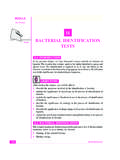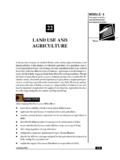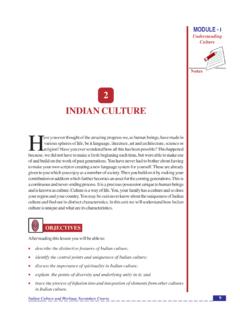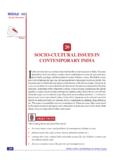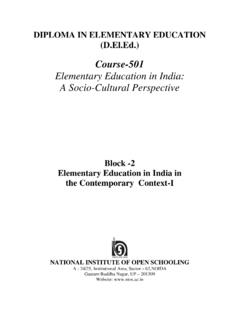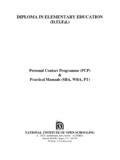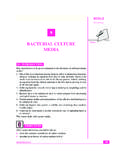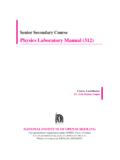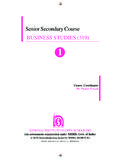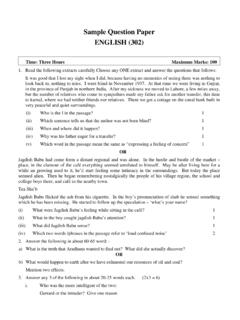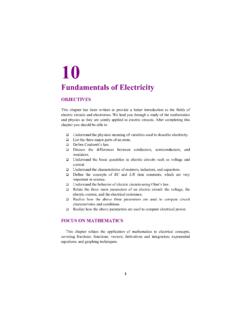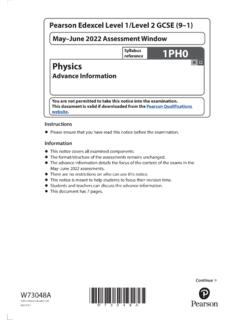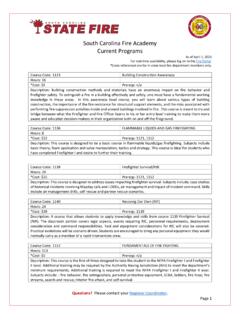Transcription of Electric Charge and Electric Field MODULE - 5
1 Notes 1 Electric Charge and Electric FieldPHYSICSMODULE - 5 electricity andMagnetism15 Electric Charge ANDELECTRIC FIELDSo far you have learnt about mechanical, thermal and optical systems and variousphenomena exhibited by them. The importance of electricity in our daily life istoo evident. The physical comforts we enjoy and the various devices used in dailylife depend on the availability of electrical energy. An electrical power failuredemonstrates directly our dependence on Electric and magnetic phenomena; thelights go off, the fans, coolers and air-conditioners in summer and heaters andgysers in winter stop working. Similarly, radio, TV, computers, microwaves cannot be operated. Water pumps stop running and fields cannot be irrigated. Eventrain services are affected by power failure.
2 Machines in industrial units can notbe operated. In short, life almost comes to a stand still, sometimes even evokingpublic anger. It is, therefore, extremely important to study Electric and this lesson, you will learn about two kinds of Electric charges, their behaviourin different circumstances, the forces that act between them, the behaviour of thesurrounding space etc. Broadly speaking, we wish to study that branch of physicswhich deals with electrical charges at rest. This branch is called studying this lesson, you should be able to :zstate the basic properties of Electric charges;zexplain the concepts of quantisation and conservation of Charge ;zexplain Coulomb s law of force between Electric charges;zdefine Electric Field due to a Charge at rest and draw Electric lines of force;zdefine Electric dipole, dipole moment and the Electric Field due to a dipole;NotesPHYSICSMODULE - 5 Electric Charge and Electric FieldElectricity andMagnetism 2zstate Gauss theorem and derive expressions for the Electric Field due to apoint Charge , a long charged wire, a uniformly charged spherical shell anda plane sheet of Charge .
3 Andzdescribe how a van de Graaff generator FRICTIONAL ELECTRICITYThe ancient Greeks observed Electric and magnetic phenomena as early as They found that a piece of amber, when rubbed, becomes electrified andattracts small pieces of feathers. The word Electric comes from Greek word foramber meaning can perform simple activities to demonstrate the existence of charges andforces between them. If you run a comb through your dry hair, you will note thatthe comb begins to attract small pieces of paper. Do you know how does ithappen? Let us perform two simple experiments to understand the a hard rubber rod and rub it with fur or wool. Next you take a glass rod andrub it with silk. Suspend them (rubber rod and a glass rod) separately with thehelp of non-metallic threads, as shown in Fig.
4 (a)(b)Fig. :Force of attraction/repulsion between charges: a) a charged rubber rod repelsanother charged rubber rod : like charges repel each other; and b) a charged glassrod attracts a charged rubber rod : unlike charges attract each 3 Electric Charge and Electric FieldPHYSICSMODULE - 5 electricity andMagnetismNow bring rubber rod rubbed with wool near these rods one by one. What doyou observe? You will observe thatzwhen a charged rubber rod is brought near the charged (suspended) rubberrod, they show repulsion [Fig. (a)]; andzwhen the charged rubber rod is brought near the (suspended) charged glassrod, they show attraction [Fig (b)].Similar results will be obtained by bringing a charged glass the basis of these observations, we can say thatzA charged rubber rod attracts a charged glass rod but repels a charged charged glass rod repels a charged glass rod but attracts a charged these activities we can infer that the rubber rod has acquired one kind ofelectricity and the glass rod has acquired another kind of electricity .
5 Moreover,like charges repel and unlike charges attract each (Benjamin Franklin, 1706 -1790) suggested that the Charge on glass rodis to be called positive and that on the rubber rod is to be called negative. Wefollow this convention since a body is charged by friction, it can be used to Charge other conductingbodies byconduction, , by touching the charged body with an uncharged body; andinduction, , by bringing the charged body close to an uncharged conductorand earthing it. Subsequently, the charged body and the earthing are Conservation of ChargeIn Activity , you have seen that when a glass rod is rubbed with silk, the rodacquires positive Charge and silk acquires negative Charge . Since both materialsin the normal state are neutral (no Charge ), the positive Charge on the glass rodshould be equal in magnitude to the negative Charge on silk.
6 This means that thetotal Charge of the system (glass + silk) is conserved. It is neither created nordestroyed. It is only transferred from one body of the system to the other. Thetransfer of charges takes place due to increase in the thermal energy of the systemwhen the glass rod is rubbed; the less tightly bound electrons from the glass rodare transferred to silk. The glass rod (deficient in electrons) becomes positivelycharged and silk, which now has excess electrons, becomes negatively rubber is rubbed with fur, electrons from the fur are transferred to - 5 Electric Charge and Electric FieldElectricity andMagnetism 4 That is, rubber gains negative Charge and fur gains an equal amount of positivecharge. Any other kind of Charge (other than positive and negative) has not beenfound till Quantisation of ChargeIn 1909, Millikan (Robert Millikan, 1886-1953) experimentally proved that chargealways occurs as some integral multiple of a fundamental unit of Charge , which istaken as the Charge on an electron.
7 This means that if Q is the Charge on anobject, it can be written as Q = Ne, where N is an integer and e is Charge on anelectron. Then we say that Charge is quantised. It means that a charged bodycannot have or amount of Charge . In units 24-26, you will learn that anelectron has Charge e and a proton has Charge + e. Neutron has no atom has equal number of electrons and protons and that is why it is this discussion, we can draw the following conclusions :zThere are only two kinds of charges in nature; positive and is is QUESTIONS A glass rod when rubbed with silk cloth acquires a Charge q = + 10 17 ) Is silk cloth also charged?ii) What is the nature and magnitude of the Charge on silk cloth?2. There are two identical metallic spheres A and B.
8 A is given a Charge + spheres are then brought in contact and then separated.(i) Will there be any Charge on B ?(ii) What will the magnitude of Charge on B, if it gets charged when in contactwith A charged object has q = 10 16 C. How many units of fundamental chargeare there on the object? (Take e = 10 19 C ). COULOMB S LAWYou have learnt that two stationary charges either attract or repel each other. Theforce of attraction or repulsion between them depends on their nature. Coulombstudied the nature of this force and in 1785 established a fundamental law governingNotes 5 Electric Charge and Electric FieldPHYSICSMODULE - 5 electricity andMagnetismit. From experimental observations, he showed that the electrical force betweentwo static point charges q1 and q2 placed some distance apart is directly proportional to their product ; inversely proportional to the square of the distance r between them; directed along the line joining the two charged particles ; and repulsive for same kind of charges and attractive for opposite magnitude of force F can then be expressed asF= k 122qqr ( )For free space, we writeF= 014 122qqr ( )where constant of proportionality k = 014 for free space (vacuum) and k = 14 for a material medium.
9 0 is called permittivity of free space and is the permittivityof the medium. It means that if the same system of charges is kept in a materialmedium, the magnitude of Coulomb force will be different from that in free constant k has a value which depends on the units of the quantities unit of Charge in SI system is coulomb (C). The coulomb is defined in termsof the unit of current, called ampere. (You will learn about it later.) In SI system ofunits, the value of k isk= 014 = 9 109 22 NmC( )since 0 = 10 12 C N 1 m in terms of force, one coulomb Charge can be defined as : If two equalcharges separated by one metre experience a force of 9 109 N, each chargehas a magnitude of one coulomb. The value of electronic Charge e is 10 19 thatzCoulomb s law is also an inverse square law just like Newton s law ofGravitation, which you studied in lesson s law holds good for point charges s force acts at a distance, unlike mechanical - 5 Electric Charge and Electric FieldElectricity andMagnetism 6 How Big is One Coulomb?
10 The unit of electrical Charge is coulomb. Have you ever thought : How biga coulomb is? To know this, let us calculate the magnitude of force betweentwo charges, each of one coulomb, placed at a distance of one metre fromone another:F= k 122qqr = 109 2111 = 109 1010 NIf the mass of a loaded passenger bus is 5000 kg, its weight mg = (5000 10) N (assume g 10 m s ) = 5 104 us assume that there are 10,000 such loaded buses in Delhi. The totalweight of all these buses will be 5 104 10,000 = 5 108 N. If thereare 10 cities having same number of buses as those in Delhi, the total weightof all these loaded buses will be 5 109 N. It means that the force betweentwo charges, each of 1C and separated by on metre is equivalent to theweight of about two hundred thousand buses, each of mass 5000 Augustin de Coulomb(1736 1806)A French physicist, Coulomb started his career as militaryengineer in West Indies.
